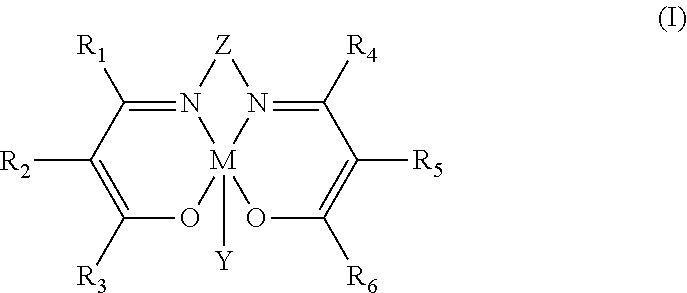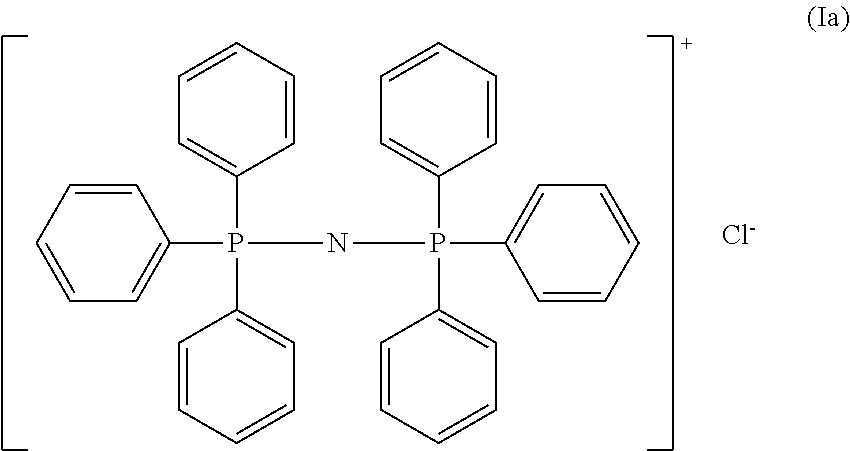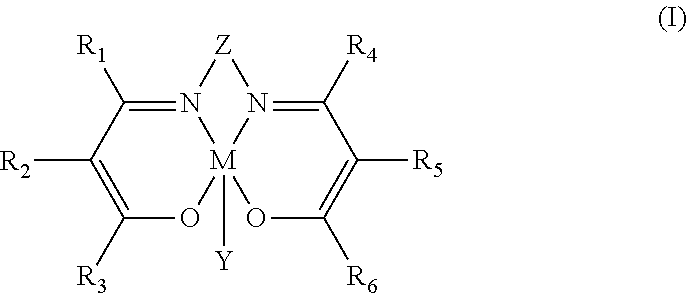Process for preparing polycarbonate and catalytic system used
- Summary
- Abstract
- Description
- Claims
- Application Information
AI Technical Summary
Benefits of technology
Problems solved by technology
Method used
Image
Examples
example 1
Synthesis of N,N′-bis(3,5-di-tert-butylsalicylidene)-1,2-cyclohexanediamino chromium(III) azide [Cr(Salen)N3]
[0145]
[0146]2 g (3.16 mmoles) of N,N′-bis(3,5-di-tert-butylsalicylidene)-1,2-cyclohexanediamino chromium(III) chloride [Cr(Salen)Cl] and 0.65 g (3.16 mmoles) of anhydrous silver perchlorate (AgClO4) were dissolved, respectively, in 120 ml (in a 200 ml two-neck flask) and in 30 ml (in a 500 ml two-neck flask) of anhydrous acetonitrile (CH3CN), under nitrogen flow (N2), at ambient temperature (25° C.). The solution of N,N′-bis(3,5-di-tert-butylsalicylidene)-1,2-cyclohexanediamino chromium(III) chloride [Cr(Salen)Cl] obtained was then dripped, in about 30 minutes, into the solution of silver perchlorate (AgClO4) obtained. The reaction mixture obtained was left, under stirring, at ambient temperature (25° C.), for one night. Subsequently, the reaction mixture was filtered in order to separate the silver chloride (AgCl) precipitate and, after filtration, 0.62 g (9.48 mmoles) of so...
example 2
Synthesis of N,N′-bis(3,5-di-tert-butylsalicylidene)-1,2-benzodiamine (SalaphenH2)
[0149]
[0150]In a 500 ml two-neck flask, 2.0 g (18.5 mmoles) of o-phenylenediamine and 8.67 g (37.0 mmoles) of 3,5-di-tert-butyl-salicylaldehyde were dissolved in 200 ml of anhydrous methanol (MeOH). A few drops (about 0.7 ml) of concentrated formic acid (HCOOH) were added to the solution obtained and the mixture was then refluxed for about 3 hours: the precipitation of a yellow-orange solid was observed. The progress of the reaction was observed through thin layer chromatography (TLC). At the end of the reaction, the solid obtained was separated through filtration, washed with cold anhydrous methanol (MeOH), subsequently dissolved in 20 ml of dichloromethane (CH2Cl2) and washed with water (2×100 ml) and subsequently with a saturated sodium chloride solution (NaCl) (2×100 ml) obtaining an aqueous phase and an organic phase that were separated through a separatory funnel. The organic phase obtained was a...
example 3
Synthesis of N,N′-bis(3,5-di-tert-butylsalicylidene)-1,2-benzodiamino chromium(III) chloride [Cr(Salaphen)Cl]
[0152]
[0153]In a 200 ml two-neck flask, 0.5 g (0.924 mmoles) of N,N′-bis(3,5-di-tert-butyl salicylidene)-1,2-benzodiamino (SalaphenH2) obtained as described in Example 2 and 0.125 g (0.996 mmoles) of chromium(II) chloride (CrCl2), were dissolved, under nitrogen flow (N2), in 50 ml of anhydrous tetrahydrofuran (THF). The solution obtained was left, under stirring, at ambient temperature (25° C.), for 24 hours, under nitrogen flow (N2) and, subsequently, for another 24 hours, in air. The mixture obtained was diluted with 50 ml of diethyl ether [(C2H5)2O], then extracted with a saturated solution of ammonium chloride (NH4Cl) (3×100 ml) and subsequently with a saturated solution of sodium chloride (NaCl) (2×80 ml) obtaining an aqueous phase and an organic phase that were separated through a separatory funnel. The organic phase obtained was anhydrified on magnesium sulfate (MgSO4)...
PUM
| Property | Measurement | Unit |
|---|---|---|
| Temperature | aaaaa | aaaaa |
| Temperature | aaaaa | aaaaa |
| Temperature | aaaaa | aaaaa |
Abstract
Description
Claims
Application Information
 Login to View More
Login to View More - R&D
- Intellectual Property
- Life Sciences
- Materials
- Tech Scout
- Unparalleled Data Quality
- Higher Quality Content
- 60% Fewer Hallucinations
Browse by: Latest US Patents, China's latest patents, Technical Efficacy Thesaurus, Application Domain, Technology Topic, Popular Technical Reports.
© 2025 PatSnap. All rights reserved.Legal|Privacy policy|Modern Slavery Act Transparency Statement|Sitemap|About US| Contact US: help@patsnap.com



